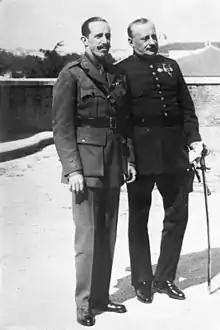Dictatorship of Primo de Rivera
The dictatorship of Primo de Rivera was the historical subperiod of the Bourbon Restoration in Spain, comprising the dictatorial government of General Miguel Primo de Rivera from 1923 to 1930, during the wider reign of Alfonso XIII.
Primo de Rivera established his dictatorship after a 1923 coup brought him into power. He suspended the 1876 Constitution, which had kept the liberal and parliamentary monarchy in power for the last 50 years.[1] However, his dictatorship ended when he resigned in 1930, and General Dámaso Berenguer succeeded him.[2]
History
General Miguel Primo de Rivera y Orbaneja entered power in September 1923 through a successful military coup in the mould of 19th century pronunciamientos that won the acquiescence of King Alfonso XIII, putting an end to the previous model of liberal and parliamentary monarchy (based on the 1876 Constitution) and, thus, undermining the constitutional legitimacy of the monarch.[1]
The first part of the dictatorship from 1923 to 1925 comprised a military directorate.[3] On 3 December 1925, Primo de Rivera installed a Civil Directorate with a Council of Ministers featuring civilians.[4]
Primo de Rivera, increasingly unpopular in the late 1920s, handed in his resignation in January 1930 after losing support from the military and the King,[5] who appointed General Dámaso Berenguer in order to replace him.
References
- Ben-Ami 1977, p. 65.
- Radcliff, Pamela Beth (2017). Modern Spain : 1808 to the Present. Hoboken, NJ: Wiley Blackwell. p. 155. ISBN 978-1-119-40685-3. OCLC 979230456.
- Casanova & Gil Andrés 2014, p. 86.
- Casanova & Gil Andrés 2014, p. 93.
- Berman 2019, p. 267.
Bibliography
- Ben-Ami, Shlomo (1977). "The Dictatorship of Primo de Rivera: A Political Reassessment". Journal of Contemporary History. 12 (1): 65. ISSN 0022-0094. JSTOR 260237.
- Berman, Sheri (2019). Democracy and Dictatorship in Europe: From the Ancien Régime to the Present Day. Oxford University Press. ISBN 9780199373208.
- Casanova, Julián; Gil Andrés, Carlos (2014). Twentieth-Century Spain: A History. Cambridge University Press. ISBN 978-1-107-01696-5.
